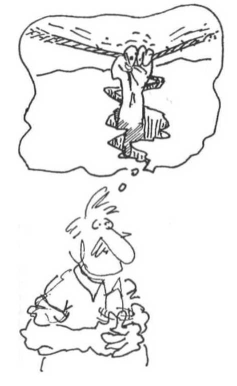"Using Your Brain —for a CHANGE" - читать интересную книгу автора (Bandler Richard Wayne)
V. Going For It
 |
In an attempt to understand why people do things, the field of psychotherapy has developed many models that they later found out simply weren't the case. However, many psychologists continue to hang on to them. We still have people who are looking for Ids and Egos, and they're as likely to find that as a "parent," a "child," or an "adult." I think that most psychologists must have watched too many horror movies when they were children. "You have a parent, an adult, and a child inside you that make you do things," It sounds like you need to be exorcised. People used to say, "The devil, made me do it." Now they say, "My parts made me do it."
"Well, you're just saying this because your 'parent' is talking.
"No I'm not; she's all the way back in New Jersey!"
Transactional Analysis is a device for separating behaviors into three parts — a little like multiple personality, except TA is supposed to be a cure. If you're really advanced, you get to have nine parts, because each of the first three parts has a parent, adult, and child inside of
How many of you have a "critical parent" voice inside you that berates you and tries to coerce you into doing things? If somebody suggests to you that there's a voice inside you that criticizes you all the time, and you start listening for it, guess what? You can install one. One interesting thing you can do is to agree with that critical voice, over and over again, until you drive it crazy. Another thing you can do is to change its location. Find out what happens if you hear that same voice coining out of your left big toe, . . . That change in location certainly changes the impact of that voice, doesn't it?
However, keep in mind that your critical voice could be right about what it's saying. Maybe you ought to listen to what it says, instead of just feeling bad. I'd like to show you what you can do with a critical voice that makes you feel bad; who has a nice loud one?
Fred: I've got one all the time.
Good. Can you hear it now?
Fred: Yes, it's criticizing me for speaking up.
Great. Ask if it will tell you
Fred: It wants me to succeed; it criticizes me when I stick my neck out.
OK, I assume that you agree with its intention. You want to succeed, too, right? Fred: Yes. Sure.
Ask that voice if it believes it has good information that would be useful for you to have and understand. . . . Fred: It says, "Of course."
Since it has good information, ask that voice if it would be willing to try changing the
Fred: It's skeptical, but it's willing to try.
Good. Now, Fred, I want to ask you to think of ways that voice could be different, so that you would listen to it better. For instance, if it used a different voice tone that was soft and friendly, would you be more apt to pay close attention to it? Would it help if that voice gave you specific helpful instructions about what to do next, rather than criticize what you've already done?
Fred: I've thought of a couple of things it could do differently.
Good. Ask the voice if it would be willing to try those out, to find out if you actually do listen better if it talks to you differently. . . .
Fred: It's willing.
Tell it to go ahead and try it out. . . .
Fred: That's amazing. It's doing it, and it's not a "critical parent" any more. It's more like a friendly helper now. It's a pleasure to listen to it.
Sure. Who wants to listen to a voice that yells and criticizes? Real parents should try this technique too, when they want their kids to listen to them. If you use a nice tonality, children will listen to you. They may not agree with what you say, but at least they'll hear it. This procedure is something we've been calling "Refraining," and it's the basis for a set of negotiation skills that are useful in family therapy and business, as well as inside your own brain. If you want to learn more about it, read the book
While the women's liberation movement has had much positive impact, in some ways it has done the same thing. The original goal was to motivate people to change the way they think about and treat women. Women got educated about what kinds of behaviors are sexist. Now when someone
If you don't want people to use sexist language, it makes better sense to make
One thing I like to do is go after women when they make sexist remarks.
A woman will say, "Well, the girls in the office — "
"How old are they?"
"Huh? They're in their 30V
"You call them
If you do something to make people feel bad when they make sexist remarks, that at least puts the motivation to change where it belongs—in the person whose behavior you want to change. However, criticizing and attacking people really isn't the best way to get them to change. The best way is to discover how they already motivate themselves, and use that.
If you ask a lot of weird questions, and if you're persistent, you can find out how anyone does anything, including motivation. Many people are troubled by "lack of motivation," and one example of that is not being able to get up in the morning. If we study those people, we can find out how not to wake up, which could be of use to insomniacs. Everything that people can do is useful to someone, somewhere, sometime. But let's find out how someone wakes up easily and quickly, without drugs. Who in here regularly wakes up easily in the morning?
Betty: I get up easily.
OK. How do you get yourself up?
Betty: I just wake myself up.
I need a little more detail than that. How do you know when you are awake? What is the first thing that you are aware of when you are awake? Does the alarm wake you up, or do you just wake up, typically?
Betty: I don't have an alarm. I just realize that I'm not sleeping.
What allowed you to know that you could say that? The voice that says, "I'm waking up," is notifying you that there is something to notice, so something must have preceded the voice. Was the voice commenting on a feeling, or was there suddenly light coming in? Something changed. Go back and remember it so that you can go through it sequentially.
Betty: I think it was a feeling.
What kind of a feeling? Warmth? Pressure?. . . .
Betty: Warm, yes.
Did you go from warmer to cooler, or from cooler to warmer?
Betty: The sensation of warmth became intensified. I felt my body get warmer.
As you began to become aware of warm feelings, you said to yourself, "I'm waking up." What happens right after that? You haven't seen anything yet? No internal images?
Betty: I said, "I have to get up."
Is the voice loud? Are there any other sounds, or is there just a voice in there? Does it have tone?
Betty: It is a very calm voice, it's an easy voice.
Does the tone of that voice inside change as you begin to wake up more and more?
Betty: Yes. It speeds up and becomes more clear and distinct, more alert.
This is an example of what we call a motivation strategy. It's not the whole thing, but it's enough to give us the key piece that makes it work to get her to do something. She has an internal voice that sounds like a sleepy, calm voice. Then as it says, "I have to get up," it begins to speed up and change that tone to on that is more awake and alert.
I want all the rest of you to try this. Doing it yourself is how you really find out about how other people do things. You don't have to say the same words, but take a moment to close your eyes, feel your body, and then listen to a voice inside your head. Have that voice begin to talk to you in a tone that is sleepy and calm. . . , Now have that voice speed up a little, become a little louder and more alert. Notice how your feelings change. . . ,
Does that affect the way you feel? If it doesn't, check your pulse. An excited internal voice is a great way to wake yourself up whenever you need it. If you start talking to yourself and putting yourself to sleep at a time when you probably shouldn't, like on the freeway, you can learn to raise the volume and pitch, talk a little faster about something that is exciting, and it will wake you right up.
This is what many insomniacs do. They talk to themselves in a loud, high–pitched, excited voice, and it wakes them up — even if they're talking about how much they need to sleep. Insomniacs tend to be very alert and motivated. They think they don't sleep much, but studies have found that they actually sleep about as much as everybody else. What's different is that they also spend a lot of time
The other main way to have insomnia is to look at lots of bright, flashing pictures, I asked one client what he did and he said, "Well, I start thinking about all the things that I may not be thinking about." I went home that night and tried it. "What is it I'm not thinking about?" Soon it was six in the morning, and I thought, "I know what it is — sleep!"
Now I want you to change your internal voice back the other way. Make it softer, lower, slower and sleepier, and notice how that makes you feel. , . .
Once I almost lost an audience doing this. Open your eyes and speed up that voice again, or you'll have to get the rest of this seminar unconsciously. This is something you can teach insomniacs, and it's also a process you can use yourself whenever you need it. For instance, I've learned that the best thing I can do on an airplane is to go unconscious. Between my house and the main airport is a short 20–minute flight. As soon as I sit down in the seat—sst—I'm out.
Man: When you're finding out how someone motivates herself, how do you know that you have gotten to the beginning of the sequence? For instance, Betty was saying the voice that was talking to her started getting louder. How do you know what questions to ask at that point?
That depends on your purpose in asking the questions. There is really no way to determine where somebody starts. You just need to get enough detail so that you can create the same experience. If I do it myself, and it works, then I've probably got enough information. The way to test these things is
Once I know someone's motivation strategy, I can literally motivate her to get out of a chair or do anything else by having her go through the same process: "Feel the chair, say to yourself, 'I have to get up.' Change your tonality and say it again in a voice that is faster, louder, and more alert." Whatever the process is that you use to get up in the morning, you probably use the same process to get yourself to walk downstairs to pick up a book, or to do anything else.
There are a lot of different ways that people use to motivate themselves. Rather than just tell you about them, I want you to get some experience of finding out about them on your own. Pair up with someone you don't know, and find out how she gets up out of bed in the morning. Everybody here had to do it at least this morning; the ones who can't do it didn't make it to this seminar. Start by asking simply, "How do you get up in the morning?" Your partner will give you one or two fairly general statements about what she does, and you'll have to ask more questions to get the rest of the details.
When you think you have the whole sequence, try it yourself to see if it works for you. For instance, your partner might say, I see the light coining in through the windows, and I say to myself, 'get up' and I get up." If you try that yourself — you look at light in the windows and say to yourself "get up" — you don't necessarily get up. It's not quite enough. You have to do more than that to make it work. People do these things automatically and unconsciously, so often you have to ask a lot of questions in order to get all the pieces.
Since this isn't a strategies seminar, I don't insist that you get every little detail. But I do want you to get the basic pieces in the sequence, and get the key piece that makes a difference. That will usually be an element that
 |
Well, what did you find in there? How does your partner motivate himself? What were the key pieces in the sequence?
Bill: My partner first hears the alarm clock, and he looks at it as he turns it off. Then he lies down again, and feels how comfortable he is in bed. An internal voice says, "If you stay here, you'll go to sleep and be late," and he makes a picture of a time when he was late to work, and feels bad. Then the voice says, "It will be worse next time," and he makes a bigger picture of what will happen if he's late again, and feels worse. The sequence seems to be "voice, picture, bad feeling." When the bad feeling is strong enough, he gets up.
That's what we call "the old anxiety routine." You keep generating unpleasant feelings until you're motivated to avoid them. Rollo May has that one. He even wrote a long book about it, which can be summarized in one sentence: "Anxiety has been misunderstood; anxiety is good because it gets people to do things."If your motivation strategy runs on anxiety, that's absolutely right. But not everyone has that kind of motivation. For other people anxiety
Suzi: I do something very similar to what Bill's partner does. I tell myself that I can rest for a few more minutes, and I do. But as time passes, my picture of being late gets bigger and closer and brighter. It stays the same picture, but when it's big enough, I have to get out of bed to stop the bad feelings.
Do you procrastinate in other things? (Yes.) How many of the rest of you did term papers at the last minute? The longer you waited, the more motivated you were. Bill's partner has his own internal anxiety generator. Suzi's runs off the clock. They are both very similar in that they use unpleasant feelings as a motivator. Did any of you find an example of motivation that used pleasant feelings — even to do an unpleasant task?
Frank: Yes, Marge pictured all the things she was going to do during the day and felt good about doing them. She said that those pleasant pictures "pulled her out of bed."
What if she only had unpleasant things to do that day? Did you ask her about that?
Frank: Yes, I did. She said she made pictures of those things being all done, and felt wonderful that they were done. That good feeling pulled her out of bed, too. That seemed unreal to me. I can't imagine that actually working, and I wanted to ask you about it.
Where's Marge? . . . Marge, when do you do your taxes? Marge: I have them done by mid–January. It's so nice to have them done, so I can do other things.
Well, it certainly seems to work for her. Nobody enjoys
Lots of people are good at motivating themselves to do pleasant things. They just make pictures of
Actually there is another piece that needs to be there if Marge's motivation strategy is going to work. How many of you have thought about how nice it will be to have something done, and then you "ran out of gas" when you sat down and started on it?
Marge, when you start on your taxes, what keeps you going?
Marge: All along, I keep thinking about how nice it will be when they're all done.
That's an important piece, but I'll bet you also do something else.
Marge: Well, each time I write down a number or fill in a piece of the form, I feel good about getting that little piece done, too. It's like a little taste of the good feeling I'll have when it's
Right. Those two pieces are what keep you going, and the second one will be more effective than the first. If you just think f it all being done, and it takes some time to finish a project, it can get to seem like "pie in the sky." But that good feeling of accomplishment you get every time you complete a small piece of the task will sustain you through a lot of drudgery.
Marge: That's interesting. It explains a lot of things in my life. People have often called me a "Pollyanna," because I'm always thinking of how good it will be when something unpleasant is over. I always get a lot done, but I've had trouble getting other people to do unpleasant jobs. When I tell them about how nice it will be when it's done, I usually get a blank stare.
Right. They just don't understand. That's not the way
Frank: It seems like you're saying that someone can be powerfully and effectively motivated without even having any unpleasant feelings. Is there any hope for the rest of us who propel ourselves with anxiety?
Sure. Like anything else people do, motivation strategies are learned, and you can always learn another one. It's fairly easy to teach you how to use Marge's strategy. But you have to be careful when you make such a pervasive change in someone's life,
Some people make lousy decisions, but since they aren't very motivated, they don't get into much trouble. If you teach them a really effective motivation strategy, they will actually carry out all those bad decisions, and do a lot of stupid, irrelevant, and possibly harmful things. So before I teach someone a powerful new motivation strategy, I make sure that the person already has an effective way of making decisions. If he doesn't, I'll teach him a new decision strategy
There are a lot of variations in how people motivate themselves, but we've already got examples of the two major patterns. Most people motivate themselves by thinking about how bad they will feel if they
A few people do the reverse, which is what Marge does. She uses pleasant feelings to move
Someone with a motivation strategy like Marge's really lives in an entirely different world than most people — a world without a lot of the anxiety, unpleasantness, and stress that many people experience.
Many people have some combination of the two. They may first think of what will happen if they don't do something, and then think of how nice it will be when it's done.
All motivation strategies work, and you can't knock something that works. However, some of them are a lot faster and more tenacious, and a lot more enjoyable than others.
A lot of the problems that bring people into therapy, or into jail, have to do with motivation. Either they're not motivated to do things they want to do, or other people want them to do, or they
 |
 |
| © 2024 Библиотека RealLib.org (support [a t] reallib.org) |